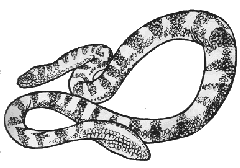| There
are three major groups of marine reptiles
on the Great Barrier Reef: sea snakes,
crocodiles and marine turtles.
Sea
snakes
Seventeen species of sea snakes have
been reported in the Great Barrier
Reef World Heritage Area. Some species
are found mostly on and around coral
reefs whereas others are found over
sandy and muddy areas of seabed. The
olive sea snake (Aipysurus laevis)
is most commonly encountered by divers
on the Reef. Like all sea snakes it
has a flattened tail and is an excellent
swimmer.
Sea
snakes are among the most venomous
snakes in the world, possessing some
of the most potent toxins known. Most
are extremely curious and will approach
divers. However, except for during
the breeding season, sea snakes are
not generally aggressive.
Sea
snakes have adapted to life in water
by developing a paddle tail and a
body shaped like the keel of a boat.
They breathe air and have valved nostrils
so that when they dive down they do
not get a nose full of water. They
usually stay down for about 20 or
30 minutes before coming up for another
breath of air. Sea snakes may feed
on fish eggs or burrowing eels, but
most feed on fish, even stonefish.
They give birth to live young in the
sea.
The
species of sea snakes found mostly
on and around coral reefs are more
or less free from human pressure.
However, some illegal collection of
olive sea snakes for the aquarium
trade does occur. Other species roam
over the seabed away from the reefs,
and these species are at risk from
being caught and killed by trawlers.
|

Sea snake image
courtesy Wet
Paper
Sea snakes have just one lung,
which occupies two thirds of their
body. Apart from breathing air
at the surface, sea snakes can
absorb about 30 per cent of the
oxygen they need from water through
their anus and skin. The extra
oxygen also helps snakes avoid
the bends by displacing nitrogen
in their blood. |
|
Salties
(estuarine crocodiles)
Estuarine crocodiles, also known as
'salties', occur along the coast of
the Great Barrier Reef Marine Park and
can be regularly found on islands in
the Far Northern Section of the Reef.
They are generally considered as temporary
migrants to the Great Barrier Reef,
as they do not spend much time in these
waters, but prefer to live in coastal
river systems. However, estuarine crocodiles
are tolerant of an extremely wide range
of fresh water and marine habitats and
have been recorded swimming strongly
in the open ocean more than 1000 kilometres
from the nearest land. Be mindful of
warning signs and always take extreme
care when visiting areas where crocodiles
might live. |
